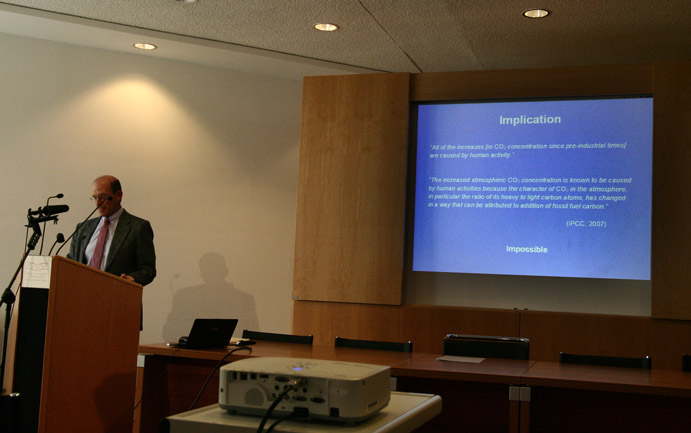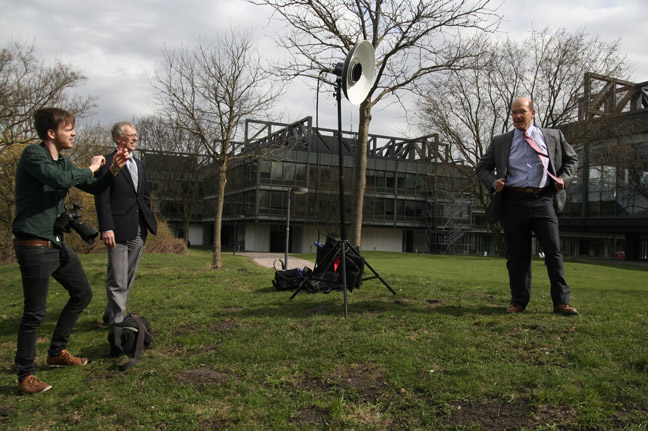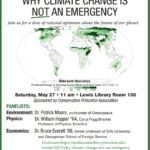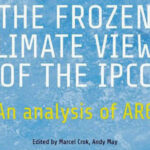Thursday at 11.00 I visited the lecture of atmospheric scientist Murry Salby in Hamburg at the Helmudt Schmidt University, the military academy.
The American Aussie is ‘on tour’ in Europe, lecturing several audiences in Paris, Cambridge and Oslo on his views on the relationship between CO2 and global temperatures on longer ánd shorter timescales, and is hailed by some blogs as a Galileo revolutionizing climate science. My blog is about the Galileo-content, and how to be skeptic on skeptics.
Salby was invited by Fritz Vahrenholt, writer of the succesfull skeptic book ‘Die Kalte Sonne’ warum der klimakatastrophe nicht statt find’. The German European Institue On Climate and Energie EIKE and the University arranged the lecture, having invited arch-sceptic Fred Singer in Hamburg 2 years earlier.
Climategate.nl: Salby-skeptics on CO2 as slave of temperature
The blogosphere is familiar with Salby’s message and conclusions after a youtube-video appeared of one of his lectures. Judith Curry’s blog highlighted this. Some laymen on carbon cycle -that want to deny human influences – even claimed, that Salby ‘proved’ the CO2-temperature relation is upside-down in Climate. CO2 is a slave of temperature on both longer and shorter time-scales.
We on Climategate.nl turned into Salby-skeptics after people like dr. Ferdinand Engelbeen on Whattsupwiththat convincingly demonstrated the contrary viewpoint of Salby. As did our homegrown carbon-cycle expert Guido here on Climategate.nl from Free University Amsterdam. In our view, Salby is confusing sink rate and source rate, interannual variation and average (upward) trend.
Pick your battles at a military university
In Marcel Crok his succesfull Dutch sceptic climatebook ‘De Staat van het Klimaat’(State of the Climate)- where I contributed on the biology part- the human fingerprint of CO2 was the only indisputable fact of climate science. There’s other nuts to crack, with ‘climate sensitivity’ and attribution being the holy grail.
But i went to Hamburg with an open mind (and because as a nature photographer I wanted to visit Ohlsdorf Cemetery), and see what valid points Salby does have. After all, his pre-retirement publication list in atmospheric physics is impressive. So he must know to some point what he’s doing.
Salby analysed year to year variations in Delta CO2 as measured by satellite. The highest variations are in the tropics above the Amazone and Africa, the most populated areas (with high CO2 emissions) have lower variations. Interannual variations show a discernable temperature effect, where CO2 is lagging temperature.
Salby on Natural C13-sources
Salby also found that the ‘human fingerprint’of CO2- the C13/C12-balance in measured CO2 -on a year to year basis -does not perfectly correlate with the constant rise of human emissions. He found an inverse relation, and thus claims there must be a non-anthopogenic CO2-source distorting the C13/C12-balance. Salby submitted a paper to the Journal of Atmospheric Science on this temperature driven lag of Delta CO2 and the fingerprint but it was rejected.
Paper submitted but rejected by JAS
According to Salby the ‘Remote Sensing’-affair and politics were behind this deciscion. According to JAS there was ‘nothing new’to Salby’s argument. Carbon Cycle-experts have told me as well: next to the average rise in CO2-content caused by anthropogenic emissions- there is interannual variation in Delta CO2 where temperature influences pe vegetation, respiration and soil moisture and thus release/uptake of CO2: but it is assumed natural resources don’t add to the budget (to the contrary, nature acts as a sink) whereas anthropogenic emissions dó.
Ice cores: 8 ppm/degree Celsius by outgassing of oceans
The CO2-contribution of outgassing of CO2 from the oceans with this minimal year to year global temperature differences is negligible according to established opinion. Even 1 degree Celsius of temperature rise – as in last century-would cause only an extra 8 ppm. This can be derived from proxy’s like icecores, where temperature variation of 8-10 degrees did not lead to more than 100 ppm extra CO2 (with a time lag of 850 yrs+, as seen in Vostok Ice Core) .
So, what was new in Hamburg? Salby attacking ice-coredata
To claim that- also in the modern erra- CO2 is a slave of temperature- is problematic in relation to proxy-evidence and everything we now know about the carbon cycle. Salby turns nature- a sink– into a CO2-source.
In Hamburg Salby thus attacked the validity of CO2-measurements in ice cores, which –according to him- are based on the wrong assumptions on conservation of CO2 in ice cores: Salby has submitted this to a journal. Thus the CO2 measured in ice does not reflect the CO2-content of atmosphere in a period. So instead of the meager delta CO2 of 100 ppm seen in the Vostok Ice Core after 8 degrees Celsius of temperature rise, historical CO2-fluctuations could be up to 15 times higher. This leads Salby to conclude that current rise in CO2-content in atmosphere would not be ‘unprecedented’.
And then returning to his earlier points, CO2 can also be a slave of temperature in the modern era, as it was between the ice ages. Salby claims a close correlation. So actually his main point is: ‘where is the natural CO2-source, ultrasensitive to temperature’ increasing the CO2-content in atmosphere with more than 30 percent in over a century?
Logically contradictive: if CO2 is slave of temperature, then why is CO2 now going up?
Salby also mentioned the fact that in last century, only in the 20-30’s ánd the late ‘70s to the ‘90’s the rise in temperature was distinct. But this- following Salby’s logic- contradicts his argument. If CO2-rise is constantly going up, and CO2 is slave of temperature, how to explain that CO2 is still rising fast while global temperatures have reached a plateau for many years?
Only one reason to neglect anthropogenic source: some people just don’t want it
Why should we look for an other CO2-source, when the obvious one is adding 8 gigatonnes of carbon (and counting) every year to the BUDGET, and even one coal plant adds more CO2 per year then the mega-eruption of Mount St Helens? Because we do not want to be fooled by others, there is no reason to instead start fooling ourselves. And what is the mystery CO2-source, if people so desperately don’t want it to be anthropogenic?
Turning plant biology upside down; difference between cycle and budget
Knowing a little on the biology of plants, it is unlikely that a small rise of average global temperature makes them a net CO2-source by enhancing respiration, a mistake many climate alarmists also make. Respiration is more influenced by drought than temperature, and temperature rise is highest in northern latitudes: here it is unlikely that average temperature will exceed the optimum for photosynthesis of C3-plants.
Instead, the speed and efficiency of photosynthesis of both C3 (optimum 25 degrees Celsius) and C4-plants is likely to be enhanced by higher average temperature, especially on northern latitudes where Delta T is highest. With the CO2 added to the atmosphere, it is thus likely that the amount of carbon IN the carboncycle of vegetation is enhanced and the speed with which it is transmitted, but not the BUDGET. It is more likely that natural sink capacity is enhanced, if carbon release from permafrost does not overrule this. Nature as CO2-source also seems to contradict the powerfull fertilisation effects observed both in laboratory experiments and field trials (FACE)
-
Salby had no answer, but the usual ‘there are many uncertainties’. This made me more uncertain of the validity of his arguments.
Lay audience and personal testimonies
Unfortunately, only laymen visited the EIKE-lecture. Though EIKE invited climate scientists like Mojib Latif who refused to come. So we ended up with the usual sorry bunch at ‘skeptic’-meetings: non-professionals motivated by politics, and annoyed by climate claptrap by journalists in popular media which most of the time is their only source on climate matters. In my view the greatest problem lies with my (lazy) colleagues, science journalists: this should be a theme of a conference.
So we had Laymen and this time a woman, who use question-time as a chance to have their testimony heard in public, in this event someone worried about her schoolgoing daughter. Other people mixed up several other debates, the one on climate sensitivity and sources of CO2. They are suspiciously motivated by one reason: we don’t care what the cause is and if it is logically sound, as long as it’s not humans. Which degrades any debate into a waste of time.
This is a pity, as
-
The Post Retirement Galileo Complex
Somehow, we find a high diversity of academic havebeens with a Galileo Complex in the skeptosphere. They believe- since time is an infinite resource after retirement- it is time to crack the nut in a field of science that has not been theirs in their professional carreer.
With their fresh senior mind and look at the subject they turn all the bookshelves and Isi Web of Science of their chosen part of climate science. In this habitat, they one day meet ‘the uncertainty monster’; the fact that in every field there are many unknowns and assumptions. No perfect relations or correlations. Scientists also happen to be fallible human beings with a mortgage, obeying to academic fashion, prestige, politics and academic group think. There is álways a chance they have been burning academic time and government money on a flogiston-theory or Piltdown man.
So what happens if the retired Galileo fights the uncertainty monster, and emerges concluding: they must all be wrong! Statistically, every year from now the chances rise that something on some day múst come out of this enterprise. The whole babyboom-generation in academia is now entering the age of retirement, the largest population of high educated people in Western history.
If we don’t want to be fooled by others, let’s not instead fool ourselves
But this fact also means the bullshit-diversity will increase exponentially, since even retired academics did not leave their human weaknesses at the faculty. Some fake-skeptics embrace everyone with academic credentials as long as the message is ‘humans are not the cause’. So how to distinguish between both?
If Salby publishes his work, and it passes the review, this should be the test and we will see. So let’s not resort to the ‘politization’-meme too often as many skeptical scientists like Christy and Lindzen have found no difficulty in having their views published. Still the event was stimulating, and I thank EIKE and prof dr. Herman Harde for their kindness and hospitality.
I had a great day at Ohlsdorf photographing the great horned owls, proving nature’s resilience between tombstones and 2 million visitors per year in the middle of Hamburg.









Het bezoek aan Hamburg levert dan een boeiende kritische beschouwing op, op daar verzamelde tegenstanders van de klimaat-ideologie:
Tegenstanders van het klimaatbeleid zijn tijden lang in het nadeel geweest, niet omdat de alarmisten zo goed waren maar omdat de skeptici te weinig overtuigend waren denk ik.
De skeptici hebben mogelijk te weinig discipline in kwaliteitsbewaking van discussieniveau gehad waardoor we dan in het nadeel zijn geraakt.
De nuance van de zogenaamde ‘Luke-warmers’ zie ik hierboven terug in Rypke’s overwegingen. Ook het noemen van de namen van Christy en Lindzen past daar bij.
Welke vragen heb je zelf gesteld, Rypke? Een uitgelezen gelegenheid om je skeptisisme over zijn theorie met hem persoonlijk aan de kaak te stellen, lijkt mij. Verder een nogal pedante en aanmatigende toon over de aanwezigen en journalisten, maar dat zijn we inmiddels al gewend.
PS and why the hell is this blog in English?
Thanks for the post Rypke
Dear Marcel; thanks and feel free to share the message.
@Tinstaafl: the blog is also made for EIKE and for an international audience.
The point is that i’m fed up with skeptic patriottism, it’s so f##king boring and attracts the wrong people, it damages the credibility of valid arguments on the skeptic side
Ik ben scpeticus in hart en nieren maar allesbehalve een skeptisch patriot. Ik zou niet eens weten wat skeptic patriotism is. Jouw verbale uitspattingen in blogs en commentaren zijn bekend, denk je dat dit je blog geloofwaardiger maakt?
Overigens geniet ik regelmatig van je deskundig betoog, maar af en toe maak je je absoluut ongeloofwaardig door je verbale diarree, een soort dr.jekyll en mr.hyde dus.
Wat ik belangrijker vond en onbeantwoord bleef, heb je Salby kritische vragen kunnen stellen? Misschien had je het niveau hiermede naar een hoger niveau kunnen tillen.
I’m looking forward to a further division between ‘skeptics’, followed by proposals from the ‘lukewarmers’ to reduce the potential risks of AGW.
Kun je wat specifieker zijn over de potentiele risico’s?
Bijvoorbeeld:
– minder sneeuw
– meer sneeuw
– meer misdaad
– klimaatvluchtelingen
– meer malaria
– meer kanker
– meer overstromingen
– meer droogte
– verdwijnen himalaya gletsjers in 2025
– hoge bloeddruk
– obesitas
– auto-immuunziekten
– burgeroorlogen
– drankzucht
– etc ??
@ Chemical: alle (totaal 334 stuks) risico’s van de AGW op een rijtje voor je.
Veel plezier:
http://www.numberwatch.co.uk/warmlist.htm
I try to answer, but I think Rypke is deleting my comments again. I don’t mind that at all (it’s his blog), although I’d prefer it if he were transparent about it or let me know that from now on I am banned at Climategate.nl.
In that case I will cease posting comments and spare him his manual labour.
@Neven: foutje: climategate is van de schrijver van deze reactie en Rypke is momenteel de meest actieve blogger. Wat mij betreft had de blog gewoon in het Nederlands gekund en had EIKE een Engelse versie gekregen. Ik moet zeggen dat ik ook heel sterk Rypke’s kritische vragen aan Salby mis…. hoewel ik tussen de regels lees dat hij ze wel heeft gesteld en dat Salby antwoordde met “uncertainties”. Jammer dat Rypke zijn vragen niet in detail heeft opgeschreven. Ook zegt hij ergens dat hij met een open mind naar Hamburg is gereden en dat hij van mening is dat Salby toch wel een beetje moet weten waarover hij spreekt. Nu heb ik meer het gevoel dat hij met een gesloten geest daarheen is gereden en dat hij van meet af aan wist dat hij de zaak wilde afbranden. Nu ben ik zelf ook wel skeptisch tav Salby en dus kan ik dat ook niet zo heel erg vinden. Rypke’s beschouwing over de gepensioneerde would-be’s verdient een aparte blog want daar zit zeker veel aan… tevens is het idd ook zwak als een wetenschapper komt jammeren dat zin artikel niet is geaccepteerd. De klimaatcensuur is toch echt wel ten einde en dus moet je degelijk werk echt wel gepubliceerd kunnen krijgen. Idd is Salby een beetje de rockstar van de sceptici zoals Marcott dat bij de alarmisten werd voor zijn werk in de pan werd gehakt. Terecht wat iemand schrijft dat de sceptische wereld ook zelfreinigend vermogen zou moeten hebben. Als Salby echt op een dwaalspoor is kan hij beter zijn mond houden. Anderzijds moet je in de wetenschap altijd ruimte laten voor de mogelijkheid dat Salby wel gelijk heeft en dat die ice cores echt niet goed zijn etc etc. Denk aan Semmelweiss… maar: klein verschil: Semmelweiss was een jonge vent en Salby is een pensionado… ik zal met Rypke contact opnemen mbt verwijderen van reacties…. dat doen we eigenlijk alleen in uitzonderlijke gevallen…
Ik lees het allemaal niet meer, maar waarom zou een “Luker” in godsnaam z’n hoofd moeten breken over oplossingen voor “de risico’s “ van AGW?
Neven heb jij er wel eens over nagedacht hoeveel CO2 er de lucht in werd en wordt gespoten door alle inspanningen, het gekraai, gedoe, de congressen van al die AGW-ers om maar te zwijgen van de uitstoot als gevolg van de schitterende, vrijheidsbeperkende maatregelen die ze de mensheid opdringen.
Het zou binnen de fluttheorie die hij aanhangt wel eens voldoende kunnen zijn op die hele Noordpool van you te doen afsmelten.
Klimatologie is nu eenmaal interdisciplinair en wetenschap vindt niet altijd plaats tussen de muren van een instituut.
En ouderen zijn niet op voorhand onder de indruk van de getallen die door computermodellen worden geproduceerd voor een virtuele werkelijkheid.
http://www.pnas.org/content/early/2012/07/06/1107482109.full.pdf+html
Hajo, ik vind het niet erg als m’n reacties verwijderd worden, maar vind het wel prettig als het transparant gebeurt. Dus een of een mailtje. Ik ben niet zo snel op m’n teentjes getrapt. Ik deel namelijk zelf ook graag uit, en dit is per slot van rekening het internet waar wat minder makkelijk een blad voor de mond genomen wordt.
Verder meen ik het als ik zeg dat ik een wellicht ontluikende tweedeling tussen ‘skeptici’ van de Salby-variant (ik ken die hele vent overigens niet, maar goed) en zogenaamde ‘lukewarmers’ interessant vind. Ik denk persoonlijk dat het een truc is, waarbij de wat radicalere elementen geofferd worden om de boel nog maximaal te kunnen vertragen. Maar dat maakt het desondanks lastiger om laissez-faire business-as-usual te propageren.
De hardcore ‘skeptici’ ontkennen namelijk dat AGW risico’s met zich meedraagt. Het risico is nul, en als er al wat gebeurt, dan is het positief. Ik ga ervan uit dat ‘lukewarmers’ in ieder geval niet zeggen dat het risico nul is, maar erg graag zullen ze er zich ook niet over uitlaten. Want op het moment dat ze dat doen, schakelt de discussie over van klimaatwetenschap naar risk management. En dat is een heel lastige discussie voor mensen die eigenlijk niet willen dat er ook maar iets gedaan wordt ter voorkoming van of aanpassing aan risico’s. Als ze al geloven dat er risico’s zijn, dan nemen ze die voor lief.
Ik kan natuurlijk in niemands hoofd kijken, maar dat is hoe ik het zie.
Ik denk bijvoorbeeld ook dat het een van de redenen is dat Marcel niet meer echt betrokken is bij Climategate.nl (en misschien Rypke overtuigd heeft hetzelfde te doen), omdat de overgebleven reageerders, zoals bijvoorbeeld Turris, ietwat te radicaal zijn. Het doet Marcels positie geen goed om daarmee geassocieerd te worden.
We praten over een opwarming van gemiddeld 0,006 Gr. Celsius per jaar: risico’s …
http://www.numberwatch.co.uk/warmlist.htm
Ik ben trouwens benieuwd naar die andere foto’s van Rypke.
Nog een vraag: Is de CO2-icecore vs. stomata-index controverse ook op gelost.
Dus ik ging wat googlen naar iets wat op kennislink stond daarover, maar ik kwam dit tegen uit 2010…
http://wattsupwiththat.com/2010/12/26/co2-ice-cores-vs-plant-stomata/
Leuk om te weten lijkt mij.
In risico management heten tegenmaatregelen “mitigatie”. Na de mitigatie afronding wordt dan het resterend risico gemeten. De mitigatie van het door het IPCC gemeten, berekende en voorspelde Global Warming risico heet het CO2-reductie-Kyoto-protocol.
Het Kyoto-protocol-verdrag heeft door haar domme constuctie juist geleid tot 30% meer CO2-uitstoot in haar verdragsperiode, terwijl de door het IPCC voorspelde extreme “warming” wel stagneerde onder invloed van andere meer klimaatbepalende factoren dan CO2.
Niet bepaald mitigatie dus, en heeft bovendien de wereldeconomie onnodig zwaar beschadigd (Lomborg) en ging ten koste van bestrijding (mitigatie) van echte wereldproblemen als honger, malaria, en ten behoeve van schoon water, micro-kredieten, vredesmissies en wereldeconomie.
Deze fouten kunnen erkennen door de politiek zal van moed getuigen.
De “benodigde” AGW-klimaat/opwarming CO2-reductie-tegenmaatregel, zoals opgenomen in het ontwerp van het VN-Kyoto-protocol-verdrag werd meteen gecorrumpeerd door het politieke primaat van de instelling van ontwikkelingshulp-certificaten (=Emissie-trading-bonds) die konden worden aangekocht, van ontwikkelingslanden, om de eigen CO2-uitstoot in de industrielanden verder te kunnen rechtvaardigen.
Kyoto-CO2-emmisie-bonds waren daarmee de “aflaten” aan de AGW-wereld-religie in stand gehouden door VN-IPCC. In de Rooms-katholieke kerkgeschiedenis zijn aflaten officieel erkend als de oorzaak en het begin van grote afscheidingen in de kerk en protesten tegen het “ware geloof”.
Dat de westerse politiek (in casu het VN-IPCC en haar VN-Kyoto-protocol) geheel niet leert van haar eigen westerse geschiedenis is een bekend feit.
De geschiedenis herhaalt zich telkens weer.
Neven interpretatie van risico-inventarisatie:
“Want op het moment dat ze dat doen, schakelt de discussie over van klimaatwetenschap naar risk management. En dat is een heel lastige discussie voor mensen die eigenlijk niet willen dat er ook maar iets gedaan wordt ter voorkoming van of aanpassing aan risico’s. Als ze al geloven dat er risico’s zijn, dan nemen ze die voor lief.”
Hij schrijft dus eigenlijk dat andere inzichten dan de zijne niet serieus genomen kunnen worden om te bepalen welke acties er ondernomen zouden moeten worden.
Ook dat aspect is dus voor Neven al “settled”.
Neven roept maar altijd wat. Van risico- & mitigatie-management, van de kanstheorie, van economische risico-voorspelmodellen en van decision tree risk-analyses heeft hij net zoveel (=weinig) kaas gegeten als de gesubsidieerde roeptoeters van Milieu-Defensie en hun politieke predikers in de Tweede Kamer.
Vanuit die dominante onkunde wordt in Nederland, gesteund door de politieke Eurofielen, de huidige klimaat-, energie- en milieu-politiek geregisseerd.
Het droevige effect voor Nederland en de negatieve resultaten voor klimaat, energie, milieu en economie zijn afdoende bekend. Ook bij minister Kamp en zijn kritisch wetenschappelijk adviseur Marcel Crok.
Neven, niemand verwijdert hier je reacties, hoe kom je daar bij?
@Hajo, er valt niets te missen aan kritische vragen van min kant maar zoals ik al schreef mis je de antwoorden daar op: die had Salby niet zoals ik schreef
Neven, niemand verwijdert hier je reacties, hoe kom je daar bij?
Een tijdje terug snipte je een comment van mij omdat ik geen opbouwende kritiek zou leveren zoals Guido. Toen ik daar vervolgens op reageerde, verschenen m’n comments niet meer. Ik ging ervanuit dat je ze weghaalde, maar liet het er verder bij zitten.
Nu kwam er wel een comment van me door. De tweede verscheen echter niet. Hierdoor ging ik er weer vanuit dat je hem weggehaald had.
Misschien dat ik ernaast zit en dat WordPress het er de ene keer wel uitfiltert en de andere keer niet. In dat geval: Sorry, en kun je ajb nog die tweede comment eruit vissen (er zat een link in naar Skeptical Science).
Het ‘inzicht’ dat de risico’s van AGW nul zijn, hoeft inderdaad niet serieus genomen te worden. Het getuigt ook van weinig skepsis.
Neven, voor alle duidelijkheid: Skepsis betekent het verwerpen van alle beweringen waar geen goed bewijs voor is.
Met betrekking tot AGW (= door mensen veroorzaakte wereldwijde opwarming) is er een drie-traps onzekerheid, die skeptici drievoudig op elkaar gestapeld wegens gebrek aan bewijs moeten opvatten als redenen om tegen klimaatbeleid te zijn, namelijk:
– in hoeverre is er nog een significante opwarming van de lucht en de zee die aan CO2 kan worden toegeschreven (niet dus),
– ten tweede in hoeverre was de opwarming van de afgelopen eeuw door mensen veroorzaakt (grotendeels duidelijk niet dus),
– ten derde in hoeverre was de opwarming van de afgelopen eeuw en de CO2-gehalte toename in de lucht schadelijk en als zodanig te kwantificeren (het heeft meer voordelen dan nadelen gehad en zal dat in de voorzienbare toekomst ook hebben).
Dat geeft aanleiding tot drie lagen van skepsis, omdat er drie lagen van onbewezen beweringen ten grondslag liggen aan het EU-beleid en het politieke klimaat-alarmisme, waar jij een vertegenwoordiger van bent, dat Europa ongeveer 245 miljard Euro per jaar kost en de economie naar de knoppen helpt en mij en anderen werkloos maakt.
Neven, je begrijpt de positie van de Luke-warmers niet of, waarschijnlijker, je geeft die om andere redenen verkeerd weer. Ik verdenk je er van de westerse wereld en onze economie opzettelijk kapot te willen maken met je boosaardig leugenachtige gemanipuleer.
Knap van Neven dat hij ook nog eens thuis is in het kwantificeren van risico-analyses.
Bij verzekeringsmaatschappijen kunnen ze dat ook heel goed en rekenen ze hun portemonnee vol met premies voor te verwachten klimaatschades.
Risicos..
De risicos van een (ondeugdelijke) keukentrapjes waar men lelijk van af kan vallen en iets kan breken zijn een wereldwijd probleem. Het probleem is vermoedelijk vele malen ernstiger dan de gevolgen van AGW.
aksiegroep voor veilige keukentrapjes
Hasn’t the good Professor heard of the 800 year lag, in the Ice Core data ?
CO2 rising now would be 800 years after the Medieval Warm Period.
Sorry Rypke,
it seemed to be, that I attended a complete different lecture than you in Hamburg. What I have heard was very consistent and plausible, although very sophisticated, but very well in line with CO2 research all over the world as far as I know it.
I had followed F. Engelbeens trials to rebut E.G. Becks findings, but am not in any way convinced that Engelbeen is right.
In contrary it is shown by observation though that the influence of CO2 concentration, but much more CO2 emissions on air temperature is rather neglible and thus by far overestimated by present IPCC research.
Your questions, which Murry acc. to you had not answered sufficiently, I had verbally understood but not what you wanted to express. My understanding was, that Murry seem to experience the same.
I do not agree either with your attitude “beeing sceptic about sceptic” That is not a value nor a motivation by itself, but may lead one into an rather aggressive mode. Being sceptic about science results I would agree on.
Beste Grüße/best regards
Michael
VP EIKE
Thanks for the writeup – it’s nice to have heard a tale from somone who was there, and you might look into Emeritus Prof. Hemann Harde (who introduced Dr., Salby).
in July, Salby got himself in the news, or at least, blogs like Nova, WUWT, Bishop Hill, and also in The Australian. Galileoo? many thought so.
This may not have been a good idea.
See:
http://www.desmogblog.com/2013/07/12/murry-salby-galileo-bozo-or-p-t-barnum
and
http://www.desmogblog.com/2013/08/25/defamation-by-internet-part-1-murry-salbys-short-lived-blog-storm
Unquestionably believe that which you stated. Your
favorite justification appeared to be on the
internet the easiest thing to be aware of. I say to you, I definitely get annoyed while people consider worries that they just do
not know about. You managed to hit the nail upon the top and defined out
the whole thing without having side effect ,
people could take a signal. Will probably be back to get more.
Thanks